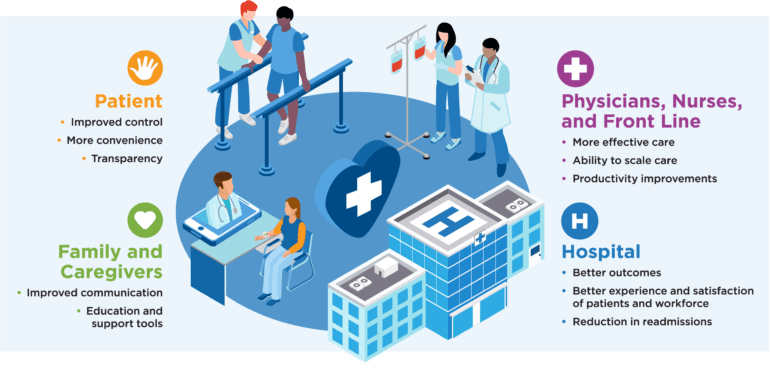Author: Mark Schrutt, Strategic Advisor, Public Sector & Innovation Research, IDC Canada
COVID-19 accelerated the digital transformation strategies of virtually every industry. This may be no truer than for Canadian healthcare. One has only to look at drug development (Cyclica, which was instrumental in the rapid development of vaccines), the pivot many companies took to manufacture PPE, and the rapid growth of personal healthcare technologies.
One area that is late to the game is hospitals. Hospitals don’t have the luxury of being able to turn on a dime. Decision makers need to navigate slow and complex provincial funding models and get buy-in from relatively large, unionized workforces.
We are beginning to see change. Transformation is partly driven by hospital management themselves, with support from regional and provincial health authorities. The overriding momentum for change is coming from patients and caregivers. While nobody will mistake dealing with hospitals as being the same as buying something from Amazon or a ride with Uber, patients nonetheless want convenience, control, and respect, these are the drivers of change and the foundation that will propel advances in Canadian healthcare.
It is happening now at the new Cortellucci Vaughan Hospital and the unique relationship it has with PX Solution’s FlexHealth suite of services. Operated by Mackenzie Health, the C$1.7 billion Cortellucci Vaughan is the first net new hospital to open in Ontario in the 21st century. One area where Cortellucci Vaughan was able to turn aspiration into reality was the hospital room, which was designed for comfort, connectivity, and care. The rooms in the hospital are intelligent and interactive. Imagine as a patient knowing which hospital staff is scheduled to visit and why. Instead of a doctor hurriedly going through the details of your procedures and recovery, all that information is at the patient’s or family’s fingertips. Digital hospital rooms are also built with advanced tools, providing continuous monitoring of patients, improving staff productivity.
MacKenzie Health had options. They selected PX Solutions due to its strong history in Canadian healthcare and a product development strategy focused in innovative, effective technologies for the healthcare profession. For example, PX Solutions operates a test lab out of its Richmond Hill head office, where they demonstrated GetWellNetwork’s digital bedside solutions.
The changes in Canadian healthcare cannot be understated. COVID-19 and digital technologies are enabling the hard shift. Patient advocacy and the needs of the caregiver are also significant themes in the transformation. The end goal is better outcomes and individual health.
The real revolution is a 360 degree view of healthcare, with a respective lens of the patient, family, and professional caregivers. Digitizing the hospital room has an important role. When people require a stay at a hospital, the patient’s room plays a big part, ensuring the flow of information and coordinating handoff from admission to discharge. The hospital room can be the epicenter for care. Unfortunately, all too frequently, there is not enough communication, and patients are not fully prepared for their rehabilitation when they are discharged.
While we are still far away from the ideal 360 degree view of healthcare, digitization of the hospital room provides part of the answer. The value to hospitals such as Cortellucci Vaughan is clear – effectiveness and staff optimization and shift towards patient-centric care.
Read more from IDC. A snapshot of bedside technologies in Canadian hospitals, download here.

